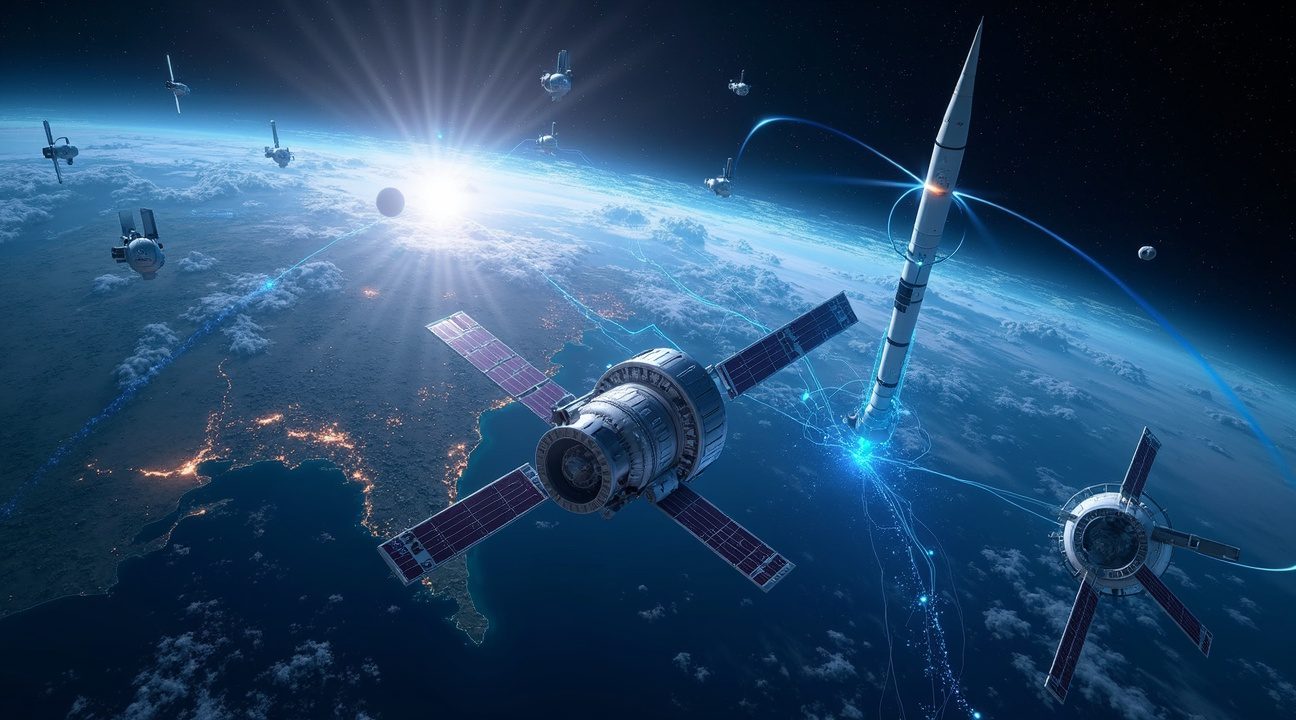Elon Musk has introduced a bold concept to use a constellation of AI-controlled satellites to reduce sunlight by 1–2% as a means of combating climate change.
Overview of the Satellite Shield Proposal
Musk’s plan envisions a mesh of satellites equipped with artificial intelligence to manage solar radiation dynamically in real-time. This effort represents a fusion of space technology and advanced AI to tackle global warming. The proposal gained over 23.5 million views on X within a single day, underscoring global curiosity and concern about radical climate innovation.
Key Takeaways
- Real-Time Sunlight Management: The envisioned system uses AI to coordinate positioning among potentially hundreds of thousands of satellites, enabling adjustments to the amount of sunlight reaching Earth for targeted cooling effects.
- Scientific Warnings: Experts highlight risks like “termination shock,” where a sudden failure of the system could cause rapid temperature spikes. Other hazards include unintended impacts on weather patterns, ecosystems, and agricultural productivity.
- Technological Roots: The concept builds on existing research in space-based solar power, which is already being pursued by countries such as China and South Korea. However, Musk’s approach differs by focusing on deflecting rather than harnessing solar energy.
- Urgency of Climate Action: With emissions expected to peak around 2028 and global temperatures projected to rise by 2.6°C by the end of the century, interest in geoengineering continues to grow amid doubts about traditional efforts to mitigate climate change.
- Futuristic Aspirations: The plan mirrors thinking associated with a Kardashev Type II civilization, which can manipulate energy on a planetary scale. Musk sees it as a natural progression of capabilities developed by companies like SpaceX and Starlink.
Potential Impact and Controversy
This idea represents a substantial shift from conventional mitigation methods, such as carbon reduction and renewable energy adoption. While it harnesses cutting-edge technologies, the satellite shield underscores the ethical, environmental, and governance challenges posed by planetary-scale geoengineering.
Musk’s AI Satellites Would Make Real-Time Adjustments to Sunlight Reaching Earth
Elon Musk’s latest proposal involves deploying a constellation of solar-powered, AI-controlled satellites that would regulate the amount of solar energy reaching Earth. I find this concept particularly ambitious because it combines space technology with artificial intelligence to address climate change through solar geoengineering.
The satellites would make minute adjustments to reduce incoming sunlight, potentially dimming solar radiation by just 1% to 2%. This small reduction could theoretically stabilize global temperatures without causing major ecosystem disruption. Musk shared this idea on X, where his message received nearly 23.5 million views within 24 hours, demonstrating significant public interest in this unconventional climate solution.
Real-Time Planetary Calculations
The AI systems would need to perform incredibly complex calculations on a planetary scale. These satellites must account for seasonal variations, hemispheric differences, and various geopolitical considerations when adjusting solar influx. I believe the technical challenges here are substantial, as the AI would need to process massive amounts of atmospheric and climate data continuously.
Each satellite would require sophisticated sensors and processing power to monitor Earth’s temperature patterns, weather systems, and regional climate variations. The AI algorithms would then coordinate adjustments across the entire constellation to ensure balanced coverage and prevent unintended regional cooling or warming effects.
Historical Climate Perspective
Musk referenced Earth’s climatic history to support his proposal, stating that “small adjustments would be enough to prevent global warming or cooling” and noting that “the Earth has snowballed many times in the past.” This historical perspective suggests that relatively minor interventions could have significant impacts on planetary temperature regulation.
The concept builds on existing solar radiation management (SRM) research, but Musk’s approach would use advanced AI and space technology rather than atmospheric aerosols or other terrestrial methods. His experience with AI systems in autonomous vehicles could potentially inform the development of these climate-controlling satellites.
However, I recognize that implementing such a system would require unprecedented international cooperation and oversight. The satellites would need to operate continuously, making split-second decisions that could affect global weather patterns and agricultural cycles. The proposal represents a bold intersection of space technology, artificial intelligence, and climate science that could reshape how humanity addresses environmental challenges.

Massive Scale Would Dwarf Current Space Infrastructure Despite Starlink Success
I’ve witnessed SpaceX transform from a startup with ambitious dreams into the operator of nearly 9,000 satellites through its Starlink constellation. This achievement demonstrates Musk’s unparalleled access to space infrastructure and his company’s ability to deploy massive satellite networks. However, these existing satellites serve internet connectivity purposes and don’t block sunlight, making them fundamentally different from what an AI-controlled climate shield would require.
The sheer scale of a sunlight-dimming satellite network would dramatically exceed even Starlink’s impressive deployment. While 9,000 satellites represent the largest constellation ever assembled, a climate intervention system would likely require tens of thousands or potentially hundreds of thousands of satellites to achieve meaningful solar radiation management effects across Earth’s surface.
Revolutionary Approach to Solar Radiation Management
Traditional solar radiation management strategies focus on terrestrial or atmospheric interventions. Scientists typically propose stratospheric aerosol injection, where particles are released into the upper atmosphere to reflect sunlight back to space. Marine cloud brightening represents another established approach, involving the enhancement of natural cloud reflectivity over oceans.
Musk’s vision breaks away from these conventional methods by proposing direct, global intervention from orbit. This space-based approach would rely on AI coordination to provide real-time sunlight regulation, adjusting coverage dynamically based on atmospheric conditions, seasonal changes, and regional climate needs. Such precision control distinguishes this concept from the relatively crude atmospheric interventions that current SRM research typically considers.
The AI component adds unprecedented sophistication to climate intervention. Rather than deploying static solutions, an intelligent satellite network could respond to weather patterns, natural disasters, and changing environmental conditions. This adaptive capability represents a significant advancement over traditional SRM methods that operate with limited feedback mechanisms.
Technical Foundation Built on Proven Space Technologies
The satellites would draw operational capabilities from established space technologies that SpaceX already masters. Photovoltaic solar panels would power each satellite, creating an interesting paradox where the very energy source they’re designed to partially block also sustains their operations. Current space technologies provide the foundation for essential functions including:
- Attitude control systems for precise positioning and orientation
- Wireless power transmission capabilities for energy distribution
- Advanced propulsion systems for orbital maintenance
- Communication networks for AI coordination
- Thermal management systems for extreme temperature conditions
SpaceX’s track record with autonomous systems and satellite deployment provides confidence in their ability to scale up operations. The company has already demonstrated expertise in mass production, rapid deployment, and orbital coordination through Starlink’s development.
The engineering challenges remain formidable despite this technological foundation. Each satellite would need sophisticated light-blocking mechanisms that can adjust opacity levels in real-time. The coordination required between thousands of satellites would demand computing power and communication capabilities far beyond current space infrastructure.
Power requirements alone would present significant obstacles. The satellites would need enough energy to operate their blocking mechanisms, maintain position, communicate with the AI network, and adjust their configurations continuously. This energy demand would far exceed what typical communication satellites require.
Manufacturing and launching such a massive constellation would require unprecedented industrial capacity. Even with SpaceX’s proven rocket capabilities, the logistics of deploying hundreds of thousands of satellites would strain current launch infrastructure and potentially require new manufacturing facilities and launch systems.
The proposal represents a fascinating intersection of established space technology and speculative climate engineering. While SpaceX has proven their ability to deploy large satellite constellations, the technical requirements for an AI-controlled sunlight regulation system would push space infrastructure into entirely uncharted territory.

Scientists Warn of Catastrophic Risks Including “Termination Shock”
The proposal has triggered intense debate among scientists and commentators, with many raising serious concerns about its feasibility, ethics, and risk profile. Experts warn that even minor miscalculations in sunlight reduction could trigger widespread disruption of photosynthesis, agriculture, and ecosystems across the planet.
Environmental and Agricultural Disruption
A reduction of even 1%–2% in sunlight could disrupt essential planetary systems that have evolved over millions of years. Agricultural yields might plummet if crops receive insufficient light for optimal growth, potentially creating food security crises. Ecosystems depend on precise solar inputs, and any alteration could cascade through food webs in unpredictable ways. Scientists also worry about altered rainfall patterns and regional climate instabilities that could shift weather systems away from their current patterns.
The phenomenon scientists call “termination shock” represents perhaps the most terrifying risk. This scenario would occur if the satellite shielding system suddenly failed or was deliberately shut down, causing rapid, catastrophic temperature increases as the full force of solar radiation returns. Unlike gradual climate change, termination shock could happen within months or even weeks, giving ecosystems and human societies no time to adapt.
Geopolitical and Control Concerns
Unresolved geopolitical concerns about control, governance, and equity plague any discussion of a global sunlight modification platform. Questions arise about who would oversee such a system and how decisions would be made about regional solar exposure. Different countries and regions might prefer different levels of shading based on their specific climate needs and economic interests.
Critics question the wisdom of relying on AI to autonomously regulate Earth’s climate. Skeptical voices express concern with statements like “So basically we’re letting AI decide how much sunlight humans get now? What could possibly go wrong?” These concerns highlight the unprecedented nature of placing artificial intelligence in control of fundamental planetary systems.
The scientific community has reached consensus that while solar geoengineering is theoretically possible, it carries significant uncertainty and the risk of unintended, potentially irreversible consequences. Elon Musk’s ambitious projects often push technological boundaries, but this proposal ventures into territory where mistakes could affect every living organism on Earth.
Many researchers argue that the complexity of Earth’s climate system makes it impossible to predict all potential outcomes of artificial solar dimming. Computer models can simulate various scenarios, but they can’t account for every possible interaction between reduced sunlight and the planet’s interconnected systems. The stakes involved make experimentation particularly risky, as there’s no way to conduct a small-scale test of global solar modification without affecting the entire planet.
Countries Race to Deploy Space-Based Solar Power as Foundation Technology
Leading Nations Pursue Orbital Energy Systems
Space-based solar power technology is rapidly advancing from concept to reality, with several countries preparing to launch demonstration projects within the next few years. This foundation technology provides crucial groundwork for Musk’s proposed climate intervention satellites, though the applications differ significantly in scope and purpose.
South Korea leads the charge with an ambitious underwater solar panel system that will feature 4,000 panels, each measuring 10 meters by 270 meters. These panels operate at 13.5% efficiency and target an impressive 1 TWh annual output. The country’s broader vision includes a massive 120 GW space solar project designed to deliver 1 TWh of electricity per year directly to Earth’s power grid.
China’s Academy of Space Technology has scheduled a demonstrator satellite launch for 2030, featuring three solar panels equipped with both microwave and laser-based transmission capabilities. This dual-transmission approach allows researchers to test different methods for beaming collected solar energy back to Earth, potentially solving one of space-based solar power’s most challenging technical hurdles.
Technology Applications: Power Delivery Versus Climate Control
The distinction between using space-based solar arrays for energy transmission versus climate intervention represents a fundamental difference in application. Current SBSP programs focus on commercial energy delivery, where satellites collect solar radiation and convert it into electrical power for Earth-based consumption. Elon Musk’s approach to space technology typically involves revolutionary applications of existing concepts.
These orbital power stations operate continuously without weather interference or day-night cycles that limit terrestrial solar installations. The technology requires sophisticated wireless power transmission systems capable of safely delivering energy across the vacuum of space to receiving stations on Earth’s surface.
Musk’s proposed satellite shield would repurpose similar solar collection technology for an entirely different function: intercepting and redirecting solar radiation before it reaches Earth’s atmosphere. Instead of converting collected energy for transmission, these satellites would simply block or reflect sunlight to reduce global warming effects.
The engineering challenges differ substantially between these applications. Power delivery satellites must maintain precise positioning relative to Earth-based receivers while managing complex energy conversion and transmission systems. Climate control satellites would require different orbital configurations and control mechanisms focused on coverage area rather than power transmission efficiency.
Several technological components remain consistent across both applications:
- Advanced photovoltaic arrays
- Lightweight structural materials
- Sophisticated attitude control systems
These form the backbone of any space-based solar platform. Autonomous systems play crucial roles in maintaining satellite positioning and operation without constant ground-based intervention.
Recent advances in launch technology have made large-scale satellite deployments increasingly feasible. Rocket launch capabilities continue expanding globally, reducing costs and increasing deployment frequency for orbital infrastructure projects.
The timeline for commercial SBSP deployment appears aggressive but achievable. Demonstration projects scheduled for 2024 will provide critical data on real-world performance and operational challenges. These early systems will inform larger-scale deployments planned for the following decade.
Financial backing for these projects reflects growing confidence in space-based solar technology. Government agencies and private investors recognize the potential for both energy security and climate intervention applications. SpaceX continues hiring talent capable of supporting these complex orbital systems.
The convergence of improving launch capabilities, advancing solar technology, and growing climate concerns creates an ideal environment for space-based solar development. Whether used for power generation or climate control, these orbital platforms represent a significant step forward in humanity’s ability to harness space-based resources for Earth’s benefit.

Climate Urgency Drives Interest in Radical Geoengineering Solutions
I’ve witnessed the climate conversation shift dramatically as traditional mitigation strategies face mounting pressure. Wood Mackenzie’s Energy Transition Outlook 2025–26 delivers a sobering reality check: global peak emissions won’t arrive until 2028, with temperatures continuing their relentless climb to 2.6°C by 2100. This timeline explains why visionaries like Musk are exploring interventions that would have seemed purely theoretical just a decade ago.
From Science Fiction to Serious Consideration
Musk’s proposal draws heavily from concepts that live at the intersection of theoretical physics and speculative engineering. His reference to controlling planetary climate directly invokes the Kardashev Type II civilization framework—a classification system describing advanced societies capable of harnessing their star’s entire energy output. Such civilizations typically construct massive megastructures like Dyson spheres, creating artificial barriers between their planet and its sun.
While Kardashev Type II remains firmly in science fiction territory, Musk’s thinking clearly operates within this paradigm. He’s already demonstrated unparalleled capability in space infrastructure deployment, making him uniquely positioned to consider such ambitious projects. The logical progression from launching communication satellites to constructing climate-controlling arrays represents exactly the kind of exponential thinking that has defined his career trajectory.
Practical Foundations for Extraordinary Claims
Musk frames his satellite shield concept as a natural evolution of existing space infrastructure. His companies already maintain operational expertise in several critical areas:
- Large-scale satellite manufacturing and deployment through Starlink operations
- Precise orbital positioning and maintenance systems
- Advanced materials engineering for space-based applications
- Automated manufacturing processes capable of scaling production
These capabilities provide concrete foundations for what might otherwise seem like pure speculation. Rather than starting from zero, Musk can build upon proven technologies and operational frameworks already generating revenue and demonstrating reliability.
The timing of his proposal coincides with growing recognition that emission reduction alone may prove insufficient. Scientists and policymakers increasingly acknowledge that even aggressive decarbonization efforts might fall short of preventing catastrophic warming. This reality gap creates space for previously unthinkable interventions to gain serious consideration.
Expert reactions reveal deep divisions about the wisdom of pursuing such radical geoengineering approaches. Some view Musk’s proposal as visionary thinking that could provide essential backup options if traditional climate strategies falter. Critics argue that focusing on speculative megaprojects distracts from proven emission reduction technologies that require immediate implementation and scaling.
The debate also reflects broader questions about technological solutionism versus systemic change. Supporters appreciate Musk’s willingness to think beyond conventional boundaries and propose solutions matching the scale of climate challenges. Skeptics worry that promoting dramatic interventions reduces pressure for the difficult political and economic transitions that emission reduction demands.
Public interest in Musk’s proposal demonstrates how climate urgency is reshaping acceptable discourse around planetary intervention. Ideas that would have been dismissed as fantasy now receive serious media coverage and academic analysis. This shift reflects growing awareness that conventional approaches may prove inadequate for addressing climate change at the speed and scale required.
The proposal also highlights how Musk’s platform influence amplifies unconventional ideas and accelerates their entry into mainstream conversation. His ability to command attention across multiple industries allows concepts to move rapidly from theoretical discussion to practical consideration.
Whether Musk’s satellite shield represents genuine innovation, desperate overreach, or calculated distraction remains hotly contested. What’s certain is that mounting climate pressure will continue driving interest in increasingly radical intervention strategies as traditional approaches strain against political and economic limitations.

Vision Reflects Kardashev Scale Thinking for Planetary Climate Control
Musk’s ambitious proposal for an AI satellite shield draws inspiration from concepts that extend far beyond current technological capabilities. I find his references to planetary climate control echo the theoretical framework of the Kardashev Type II civilization — a society advanced enough to harness the complete energy output of its star. This classification system, developed by Soviet astronomer Nikolai Kardashev, envisions civilizations capable of constructing massive structures like Dyson spheres around their stars.
The satellite shield concept represents a significant leap from existing space-based solar technologies. While current solar power satellites remain largely experimental, Musk’s vision scales this technology to planetary-level climate intervention. His proposal transforms theoretical megastructures into what he presents as a practical climate solution.
Musk positions this ambitious project as a natural progression of his existing space infrastructure achievements. His leadership in satellite deployment through Starlink provides the foundation for this expanded vision. The thousands of satellites already orbiting Earth through his SpaceX network demonstrate the feasibility of large-scale space infrastructure deployment.
Debate Intensifies Around Technological Ambition vs. Climate Reality
The proposal has sparked intense discussion among experts and the public about its underlying motivations. Critics question whether such grand technological solutions reflect genuine climate innovation or serve as diversions from proven emission reduction strategies. Some view the satellite shield as evidence of technological optimism pushed to its limits, while others see it as climate desperation driving increasingly radical interventions.
Supporters argue that Musk’s track record with electric vehicles and space technology validates his ability to transform seemingly impossible concepts into reality. His success with autonomous vehicle development and Mars colonization plans demonstrates his capacity for turning science fiction into engineering projects.
The debate extends beyond technical feasibility to fundamental questions about humanity’s relationship with planetary systems. Musk’s approach suggests treating Earth’s climate as an engineerable system, controllable through advanced technology rather than behavioral change alone. This perspective aligns with his broader philosophy of using innovation to solve existential challenges, from sustainable transportation to space exploration.
Sources:
PV Magazine USA – “Elon Musk proposes solar-powered AI satellite network to fight global warming”
Futurism – “Elon Musk’s Satellites Could Control Climate”
The Economic Times – “Elon Musk wants AI satellite constellation to prevent sunlight from warming Earth”
Interesting Engineering – “Elon Musk suggests AI satellites could dial down global warming”
Perplexity – “Musk Proposes AI Satellites to Dim Sun and Fight Warming”


